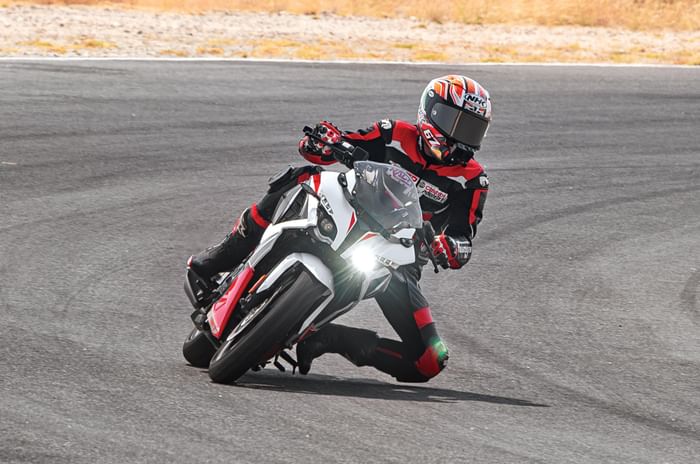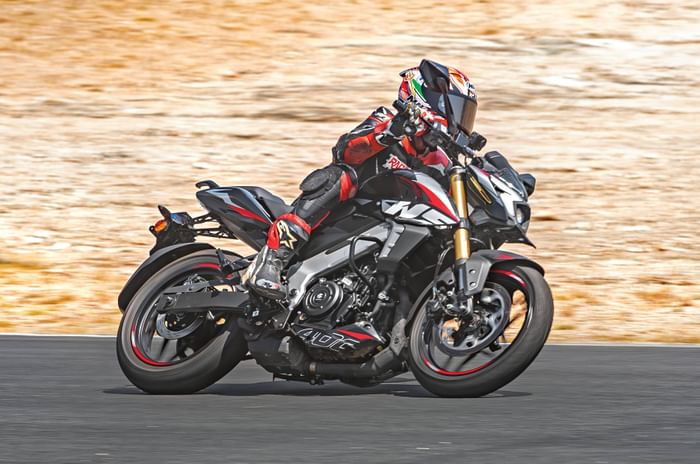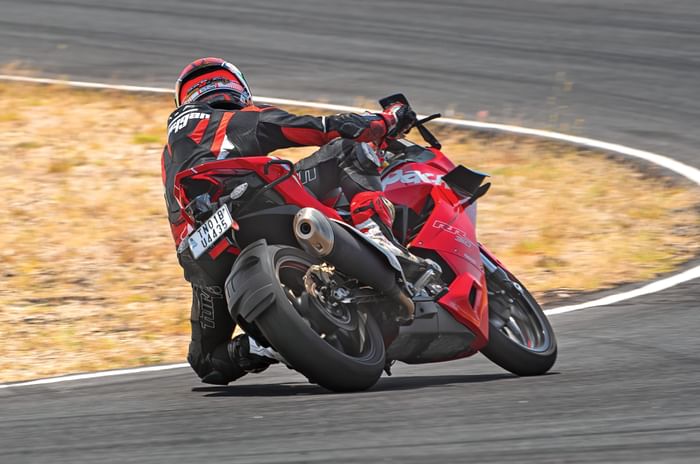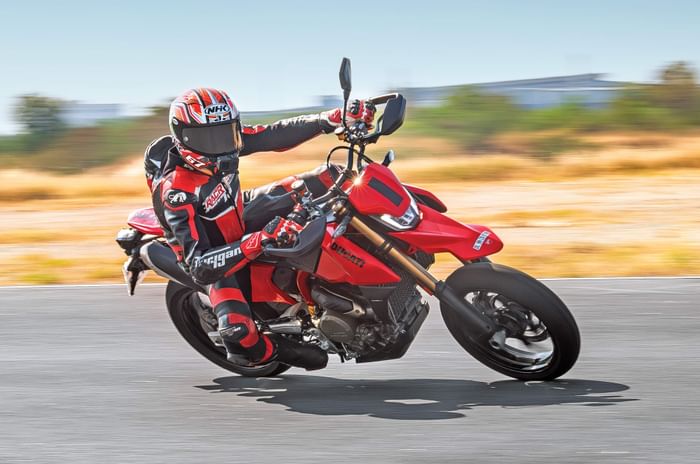We return to CoasTT with bikes like the Suzuki GSX-8R, Yamaha R3, Aprilia Tuono 457, Bajaj Pulsar RS200 and more to find out which is the fastest.
Back to our favourite time of the year – the annual Autocar Track Day – and we happily made the trip to the CoASTT High Performance Centre in Coimbatore once more. For the 2025 edition, too, we had the 11-time national champion Rajini Krishnan to put the bikes through their paces, but some things did change.

Rishaad and Rajini discuss the bikes before the day starts.
For one, the heat wasn’t as unforgiving as last year, and the track’s surface had improved in some crucial areas, especially certain corners. As it was our second visit to CoASTT, Rajini was better equipped to set quicker lap times. With the leaderboard from last year etched in our minds, we brought along some of the newest, most exciting bikes that had launched recently, as well as some older models. One must bear in mind that CoASTT is a fast and flowing track with elevation changes, and to set a good lap time here (more so than on the other tracks), you need a healthy dose of power.

Much lower pressures for track riding.
The formula for our Track Day is pretty straightforward – Rajini takes each bike out for some blazingly quick laps before moving on to the next one. The bike setup is usually minimal, with Rajini setting his preferred tyre pressures for each machine – usually a fair deal lower than the manufacturer’s recommended pressures for street use.

VBox accurately measures each bike’s lap times.
If a bike has adjustable suspension, Rajini may make some tweaks if he feels the need to. And finally, electronic rider aids like traction control and ABS are usually set to their least intrusive setting (or sometimes even turned off) because elite racers like Rajini prefer to keep the control in their own hands.
Bajaj Pulsar RS200
Lap time: 2m18.50s
Track rating: 6/10
| Bajaj Pulsar RS200 price, specifications | |
|---|---|
| Price | Rs 1.74 lakh |
| Engine | Single-cyl, 199.5cc, liquid-cooled |
| Power | 24.5hp at 9,750rpm |
| Torque | 18.6Nm at 8,000rpm |
| Gearbox | 6-speed |
| Wheelbase | 1355mm |
| Seat height | 810mm |
| Kerb weight | 165kg |
| Brakes (F/R) | 300mm disc / 230mm disc |
| Tyres (F/R) | 100/80-17 / 130/70-17 |
The first bike that went out on track, the Pulsar RS200, was actually the oldest model we had this year. While the bike has received a small cosmetic update for 2025, it is largely the same machine we’ve come to know over the past decade. But that’s not a bad thing. The KTM-derived engine has good power, and Rajini said that he liked the bike’s friendly demeanour around the track.
Despite the RS200’s relaxed, commuter-y ergos, Rajini felt that the bike was very flickable and easy to turn in the corners. He also didn’t grind the pegs at any point (you’ll see why I’ve brought this point up in just a minute) and felt that the front end was quite good. Rajini positively remarked on the Grimeca brakes for providing enough stopping force and feeling good enough for the power available on the Pulsar RS200.
Ultimately, though, since the RS200 has a rather peaky, rev-happy engine, its lap time took a hit because the power band wasn’t a very wide one.

Its front-end feel helps it turn quicker, and it has decent power and braking performance.
Ultraviolette F77 Mach 2 Recon
Lap time: 2m17.12s
Track rating: 6/10
| Ultraviolette F77 Mach 2 Recon price, specifications | |
|---|---|
| Price | Rs 3.99 lakh |
| Motor | PMSM, air-cooled |
| Power | 40hp |
| Torque | 100Nm |
| Gearbox | Single-speed |
| Wheelbase | 1340mm |
| Seat height | 800mm |
| Kerb weight | 207kg |
| Brakes | 320mm disc / 230mm disc |
| Tyres | 110/70-R17 / 150/60-R17 |
The F77 Mach 2 Recon is the first electric bike we have had at our annual Track Day, and while we were not sure what to expect, we were quite excited about it, as our previous experience indicated that this could be a quick bike. At 207kg, this top Recon variant of the F77 Mach 2 was the heaviest bike we had, but its motor also made the most torque in this company.
Unfortunately, the bike began to suffer a sizeable drop in power after a couple of laps of flat-out riding, and there was no scope for improving the lap time. That was a pity because this bike has quite a unique riding experience without any gears to change, and Rajini would have surely adapted to that in a few laps and pulled out a much quicker lap time.
That said, he was very positive about how much fun the bike would be to ride on the street, thanks to its strong and enjoyable torque delivery.

The front end feels heavy on track; the power dropped after a few laps.
Suzuki Gixxer SF 250 Flex Fuel
Lap time: 2m13.75s
Track rating: 7/10
| Suzuki Gixxer SF 250 Flex Fuel | |
|---|---|
| Price | Rs 2.17 lakh |
| Engine | Single-cyl, 249cc, air/oil-cooled |
| Power | 27.9hp at 9,300rpm |
| Torque | 22.5Nm at 7,500rpm |
| Gearbox | 6-speed |
| Wheelbase | 1345mm |
| Seat height | 800mm |
| Kerb weight | 163kg |
| Tyres (F/R) | 300mm disc / 220mm disc |
| Brakes (F/R) | 110/70-R17 / 160/60-R17 |
The bike that went out on track right after the Pulsar RS200 was the Suzuki Gixxer SF 250 Flex Fuel, and straightaway, we could see that Rajini was looking more confident, relaxed and faster on this bike. And the proof of the pudding was in the lap times – the Suzuki was 4.75 seconds quicker than the Bajaj!
Rajini explained that the big delta between the lap times came down to two things – the well-setup chassis and the grunty engine, which aided acceleration. While this Flex Fuel variant we had is capable of using E85 fuel, we were running it on standard 91 octane petrol.
However, Rajini said he found that the brakes aren’t as good as he’d have liked, with a rather conservative ABS robbing him of stopping power. He also noted that the footpegs scraped a little too easily, which restricted corner speeds.

The strong points here are its throttle response and handling, but the footpegs touch too soon.
Bajaj Pulsar NS400Z
Lap Time: 2m08.30s
Track rating: 7/10
| Bajaj Pulsar NS400Z price, specifications | |
|---|---|
| Price | Rs 1.84 lakh |
| Engine | Single-cyl, 373cc, liquid-cooled |
| Power | 40hp at 8,800rpm |
| Torque | 35Nm at 6,500rpm |
| Gearbox | 6-speed |
| Wheelbase | 1344mm |
| Seat height | 807mm |
| Kerb weight | 174kg |
| Brakes (F/R) | 320mm disc / 230mm disc |
| Tyres (F/R) | 110/70-17 / 140/70-17 |
The Bajaj Pulsar NS400Z is the most affordable 40hp bike in the country, and as we’ve mentioned before, power is a crucial aspect for setting a good lap time on this track. And the biggest Pulsar managed a commendable lap time for the sort of motorcycle it is – a friendly, relaxed street naked. Just for some context, its lap time was quicker than both the Apache 310s we had last year.
While the strong performance of the previous-gen 390 Duke-derived engine has shouldered the lion’s share of the Pulsar’s lap time, Rajini said he was quite happy with the brakes and suspension, too. This was quite pleasant to hear, given that Bajaj has used budget-friendly motorcycle parts to keep the Pulsar’s price in check.
One facet of the bike that Rajini didn’t enjoy was that the footpegs scraped too easily. But at the end of the day, the way the NS400Z performs is remarkably impressive for a motorcycle meant to be all about affordable performance on the street.

Its torquey nature helps with the track’s flowing layout, and its handling is nice too.
Yamaha YZF-R3
Lap Time: 2m06.81s
Track rating: 7/10
| Yamaha R3 price, specifications | |
|---|---|
| Price | Rs 3.60 lakh |
| Engine | Twin-cylinder, 321cc, liquid-cooled |
| Power | 42hp at 10,750rpm |
| Torque | 29.5Nm at 9,000rpm |
| Gearbox | 6-speed |
| Wheelbase | 1380mm |
| Seat height | 780mm |
| Kerb weight | 169kg |
| Brakes (F/R) | 298mm disc / 220mm disc |
| Tyres (F/R) | 110/70-R17 / 140/70-R17 |
Perhaps the bike that Rajini was most familiar with in this year’s line-up was this blue one, because his personal race bike with which he competes in the INMRC (and has won a gaggle of races) is a highly modified R3.
The R3 we get in India is a pretty old bike now (more on that later), having been on sale internationally since 2019, but even so, its screaming twin-cylinder engine and communicative chassis helped it set a decently quick lap time. In fact, Rajini says he could have gone even faster on the R3 if it had a more supportive rear shock and better tyres.
One area where everyone has left the R3 behind is in terms of equipment. Rajini specifically said that the lack of a quickshifter or even something as commonplace as a slipper clutch is a glaring miss in this day and age – not only because they look good on the brochure but also because they would have looked good on the racetrack.

The engine and chassis are very good, but the R3 is missing quite a few features.
TVS Apache RR 310
Lap time: 2m06.75s
Track rating: 8/10
| TVS Apache RR 310 price, specifications | |
|---|---|
| Price | Rs 2.75 lakh |
| Engine | Single-cylinder, 312cc, liquid-cooled |
| Power | 38hp at 9,800rpm |
| Torque | 29Nm at 7,900rpm |
| Gearbox | 6-speed |
| Wheelbase | 1365mm |
| Seat height | 800mm |
| Kerb weight | 174kg |
| Brakes (F/R) | 300mm disc / 240mm disc |
| Tyres (F/R) | 110/70-ZR17/ 150/60-ZR17 |
Moving on from a bike that’s lacking features, we come to one that has had the kitchen sink thrown at it – including winglets! The Apache RR 310 has always been a friendly yet capable track tool, and the changes TVS has peppered it with for this year have made it over 6 seconds faster on track compared to last year’s model. In terms of lap times, that’s light years ahead! Of course, part of the reason behind such a big difference is that last year’s bike was not in very good condition, but that doesn’t take away from the fact that the latest improvements have made this a faster motorcycle.
A reason why the TVS was able to beat the R3 is its high level of componentry – think sticky Michelin Road 5 tyres, fully adjustable suspension (which Rajini put to good use) and the seamless bidirectional quickshifter.
Rajini only wished the traction control was less intrusive, and he turned the system off entirely for his flying lap.

The bike’s power was very good after TC was switched off, and it has impressive features.
Aprilia Tuono 457
Lap Time: 2m00.97s
Track rating: 8/10
| Aprilia Tuono 457 price, specifications | |
|---|---|
| Price | Rs 3.95 lakh |
| Engine | Twin-cylinder, 457cc, liquid-cooled |
| Power | 47.6hp at 9,400rpm |
| Torque | 43.5Nm at 6,700rpm |
| Gearbox | 6-speed |
| Wheelbase | 1360mm |
| Seat height | 800mm |
| Kerb weight | 175kg |
| Brakes (F/R) | 320mm disc / 230mm disc |
| Tyres (F/R) | 110/70-R17 / 150/60-R17 |
I will very freely admit that I was rooting for the Aprilia Tuono 457 a little more than I was for the other machines we had when Rajini was heading out on it. And when he returned after setting almost the same lap time as the RS did last year, I was overjoyed. But let’s be objective for a second here; the Tuono isn’t the greatest thing since sliced bread (as I presume it to be).
There are a couple of factors that worked to make the Tuono as fast as the RS. Firstly, the track’s surface had improved compared to our previous visit. Secondly, the Tuono came to us specced with the Rs 20,000 accessory quickshifter, which helped shave some crucial tenths off the lap time.
As with the RS, the Tuono’s handling and torquey engine remain its strong points, and its more amenable ergos didn’t really hold Rajini back.

The accessory quickshifter really helps on track, and the handling and engine are awesome!
Ducati Hypermotard 698 Mono
Lap Time: 1m59.77s
Track rating: 7/10
| Ducati Hypermotard 698 Mono price, specifications | |
|---|---|
| Price | Rs 16.50 lakh |
| Engine | Single-cylinder, 659cc, liquid-cooled |
| Power | 77.5hp at 9,750rpm |
| Torque | 63Nm at 8,000rpm |
| Gearbox | 6-speed |
| Wheelbase | 1443mm |
| Seat height | 904mm |
| Kerb weight | 151kg (no fuel) |
| Brakes (F/R) | 320mm disc / 245mm disc |
| Tyres (F/R) | 120/70-ZR17 / 160/60-ZR17 |
“Too much fun!” were Rajini’s first words once he entered the pit lane after completing his session aboard the Ducati Hypermotard 698 Mono. And that perfectly encapsulates the riding experience it aims to provide. With the world’s most powerful single-cylinder engine powering this tall (but lightweight) supermoto, Rajini was popping wheelies out of multiple corners, especially the slow second-gear ones. The Mono also packs in some premium componentry with a radial monobloc Brembo M4.32 front caliper, fully adjustable suspension and sticky Pirelli Diablo Rosso 4 tyres.
Ultimately, all that fun did come at the expense of lap times, and while the Mono did breach the 2-minute mark (just about), this isn’t a machine built for chasing tenths on a racetrack. That said, Rajini said if he could ride only one bike again, it would be this – simply because of its recipe of uncompromisingly brash and unadulterated fun!

The Mono is a lot of fun because of its torquey motor, and it would be thrilling on a go-kart track.
Suzuki GSX-8R
Lap Time: 1m58.25s
Track rating: 8/10
| Suzuki GSX-8R price, specifications | |
|---|---|
| Price | Rs 9.25 lakh |
| Engine | Twin-cylinder, 776cc, liquid-cooled |
| Power | 82hp at 8,500rpm |
| Torque | 78Nm at 6,800rpm |
| Gearbox | 6-speed |
| Wheelbase | 1465mm |
| Seat height | 810mm |
| Kerb weight | 205kg |
| Brakes (F/R) | 310mm discs / 240mm disc |
| Tyres (F/R) | 120/70-ZR17 / 180/55-ZR17 |
At the start of the day, if you’d told me that the Suzuki GSX-8R was going to be faster than the Ducati Hypermotard 698 Mono, I’d have labelled you a madman and shooed you away. But that’s precisely what happened, and in trademark Japanese fashion, these bikes perform a fair deal higher than what the spec sheet would suggest.
Of course, the GSX-8R’s 776cc mill churns out a respectable 82hp and 78Nm of torque, but more than the outright peak power, Rajini praised this motor’s linear power delivery and responsive nature. He was also impressed by the slick bidirectional quickshifter, which is always a helpful feature when you’re trying to shave every last tenth off the lap time. In typical Suzuki fashion, Rajini found the 8R’s chassis to be very well-judged as well and praised the ergonomics, which are conducive to track riding despite being nowhere close to as committed as a proper supersport.

The engine is very smooth and has predictable power delivery.
But he did feel that the bike was a bit of a conservative package. The non-switchable ABS robbed him of outright braking power when he was at the limit, and the footpeg feelers scraping everywhere (just like the Gixxer 250) was another factor that prevented him from going as fast as he could.
Ultimately, he found the GSX-8R to be a stylish and well-rounded package, which you can ride every day thanks to its comfortable ergonomics and torquey engine and take to the track courtesy of its well-setup chassis.

The bike handles very well and can be used every day, too.
And that brings us to the end of this year’s Track Day, our second one at CoASTT. Before we wrap up, you may have noticed that we still haven’t run any high-powered superbikes here yet. By next year’s edition, the track should be complete with kerbs and finished run-off sections, at which point Rajini will be able to unleash the full fury of a 200+ horsepower track bike. Until next time, dear reader, and you can bet we will return with some exciting machines!

Also See: Autocar Track Day 2025 video: Bikes

